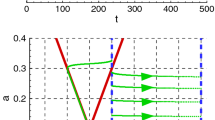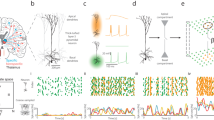Abstract
Using a population density approach we study the dynamics of two interacting collections of integrate-and-fire-or-burst (IFB) neurons representing thalamocortical (TC) cells from the dorsal lateral geniculate nucleus (dLGN) and thalamic reticular (RE) cells from the perigeniculate nucleus (PGN). Each population of neurons is described by a multivariate probability density function that satisfies a conservation equation with appropriately defined probability fluxes and boundary conditions. The state variables of each neuron are the membrane potential and the inactivation gating variable of the low-threshold Ca2+ current I T . The synaptic coupling of the populations and external excitatory drive are modeled by instantaneous jumps in the membrane potential of postsynaptic neurons. The population density model is validated by comparing its response to time-varying retinal input to Monte Carlo simulations of the corresponding IFB network composed of 100 to 1000 cells per population. In the absence of retinal input, the population density model exhibits rhythmic bursting similar to the 7 to 14 Hz oscillations associated with slow wave sleep that require feedback inhibition from RE to TC cells. When the TC and RE cell potassium leakage conductances are adjusted to represent cholingergic neuromodulation and arousal of the network, rhythmic bursting of the probability density model may either persists or be eliminated depending on the number of excitatory (TC to RE) or inhibitory (RE to TC) connections made by each presynaptic cell. When the probability density model is stimulated with constant retinal input (10–100 spikes/sec), a wide range of responses are observed depending on cellular parameters and network connectivity. These include asynchronous burst and tonic spikes, sleep spindle-like rhythmic bursting, and oscillations in population firing rate that are distinguishable from sleep spindles due to their amplitude, frequency, or the presence of tonic spikes. In this context of dLGN/PGN network modeling, we find the population density approach using 2,500 mesh points and resolving membrane voltage to 0.7 mV is over 30 times more efficient than 1000-cell Monte Carlo simulations.
Similar content being viewed by others
References
Casti AR, Omurtag A, Sornborger A, Kaplan E, Knight B, Victor J, Sirovich L (2002) A population study of integrate-and-fire-or-burst neurons. Neural Comput. 14(5): 957–986.
Destexhe A, Bal T, McCormick DA, Sejnowski TJ (1996) Ionic mechanisms underlying synchronized oscillations and propagating waves in a model of ferret thalamic slices. J. Neurophysiol. 76(3): 2049–2070
Destexhe A, Contreras D, Steriade M (1998) Mechanisms underlying the synchronizing action of corticothalamic feedback through inhibition of thalamic relay cells. J. Neurophysiol. 79(2): 999–1016
Destexhe A, Neubig M, Ulrich D, Huguenard J (1998) Dendritic low-threshold calcium currents in thalamic relay cells. Neuroscience 18(10): 3574–3588
Gerstner W (2000) Population dynamics of spiking neurons: Fast transients, asynchronous states, and locking. Neural Comput. 12(1): 43–89
Golomb D, Wang XJ, Rinzel J (1994) Synchronization properties of spindle oscillations in a thalamic reticular nucleus model. J. Neurophysiol. 72(3): 1109–1126.
Haskell E, Nykamp DQ, Tranchina D (2001) Population density methods for large-scale modelling of neuronal networks with realistic synaptic kinetics: cutting the dimension down to size. Network: Comput. Neural. Syst. 12: 141–174.
Huertas MA, Smith GD (2006) A two-dimensional population density approach to modeling the dLGN/PGN network. Neurocomputing (in press).
Huertas MA, Groff JR, Smith GD (2005a) Feedback inhibition and throughput properties of an integrate-and-fire-or-burst network model of retinogeniculate transmission. J Comput. Neurosci. 19(2): 147–180.
Huertas MA, Groff JR, Smith GD (2005b) The effect of feedback inhibition on throughput properties of the dLGN/PGN. Neurocomputing 65–66: 499–505
Huguenard JR, McCormick DA (1992) Simulation of the currents involved in rhythmic oscillations in thalamic relay neurons. J. Neurophysiol. 68(4): 1373–1383
Hundsdorfer W, Verwer JG (2003) Numerical Solution of Time-Dependent Advection-Difusion-Reaction Equations. Springer-Verlag, Berlin.
Kaplan E, Purpura K, Shapley RM (1987) Contrast affects the transmission of visual information through the mammalian lateral geniculate nucleus. J. Physiol. (Lond.) 391: 267–288
Kaplan E, Mukherjee P, Shapley RM (1993) Information filtering in the lateral geniculate nucleus. In: R Shapley, D Lam, eds. Contrast Sensitivity, vol. 5, The MIT PressCambridge, Massachusetts, pp. 183–200
Kim U, McCormick DA (1998) The functional infuence of burst and tonic fring mode on synaptic interactions in the thalamus. J. Neurosci. 18(22): 9500–9516.
Knight BW, Manin D, Sirovich L (1996) Dynamical models of interacting neuron populations. In: EC Gerf ed., Symposium on robotics and cybernetics: computational engineering in systems applications. Lille, France, Cite Scientifique.
McCormick DA, Huguenard JR (1992) A model of the electrophysiological properties of thalamocortical relay neurons. J. Neurophysiol. 68(4): 1384–1400.
Mukherjee P, Kaplan E (1998) The maintained discharge of neurons in the cat lateral geniculate nucleus: spectral analysis and computational modeling. Vis. Neurosci. 15: 529–539
Nykamp DQ, Tranchina D (2000) A population density approach that facilitates largescale modeling of neural networks: analysis and an application to orientation tuning. J. Comput. Neurosci. 8(1): 19–50.
Nykamp DQ, Tranchina D (2001) A population density approach that facilitates largescale modeling of neural networks: extension to slow inhibitory synapses. Neural Comput. 13(3): 511–546.
Rinzel J, Terman D, Wang XJ, Ermentrout B (1998) Propagating activity patterns in large-scale inhibitory neuronal networks. Science 279(5355): 1351–1355
Sherman SM, Guillery RW (1996) The functional organization of thalamocortical relays. J. Neurophysiol. 76: 1367–1395
Sherman SM, Koch C (1990) Thalamus. In: GM Shepherd ed, Synaptic Organization of the Brain, (3 Edn.), Oxford University Press New York, pp. 246–278
Smith GD, Cox CL, Sherman SM, Rinzel J (2000) Fourier analysis of sinusoidallydriven thalamocortical relay neurons and a minimal intergrate-and-fire-or-burst model. J. Neurophysiol. 83(1): 588
Troy JB, Robson JG (1992) Steady discharges of X and Y retinal ganglion cells of cat under photopic illuminance. Vis. Neurosci. 9: 535–553
Wang XJ, Golomb D, Rinzel J (1995) Emergent spindle oscillations and intermittent burst firing in a thalamic model: specific neuronal mechanisms. Proc. Nat. Acad. Sci. 92(12): 5577–5581
Author information
Authors and Affiliations
Corresponding author
Additional information
Action Editor: David Golomb
Rights and permissions
About this article
Cite this article
Huertas, M.A., Smith, G.D. A multivariate population density model of the dLGN/PGN relay. J Comput Neurosci 21, 171–189 (2006). https://doi.org/10.1007/s10827-006-7753-2
Received:
Revised:
Accepted:
Published:
Issue Date:
DOI: https://doi.org/10.1007/s10827-006-7753-2




